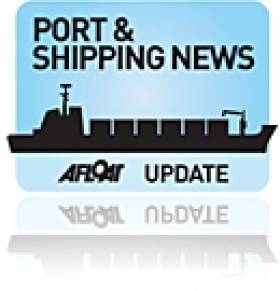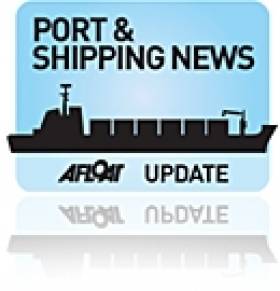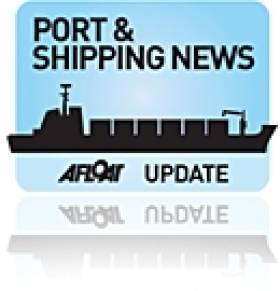Displaying items by tag: Irish manufacturing growth
IMDO Shipping Review: Irish Manufacturing Growth,Panamax Market Overcapacity, New Shipping Bank and more
#Ports&Shipping –The latest IMDO Weekly Shipping Market Review includes the following stories as detailed below.
Irish Economy: Manufacturing Improves - The Irish manufacturing sector showed continued growth in September, with the release of the Investec Manufacturing Purchasing Managers Index (PMI) highlighting a 14-month high figure of 52.7 points, up from 52.0 in August. New orders, down 0.1 points from a 13-month high of 53.6 in August, recorded continued growth in both domestic andexport markets, leading to the rise in overall production during the month.
Container Market: Panamax Vessels Threatened by Cascading - The Panamax container market may experience overcapacity according to Lloyd's List if other carriers follow Maersk's lead to replace chartered tonnage after cascading its Triple-E 18,270 TEU capacity vessels. Cascading is the process of moving larger vessels from main trade routes onto smaller trade routes as they are displaced from the main trade routes by the entrance of even larger ships.
Finance: Dedicated Shipping Bank - Solace for second-tier shipowners has arrived as a group of shipping executives have launched the Maritime and Merchant Bank in Oslo, claiming the industry needs a financial institution to fill the void created by the main banks and lenders leaving the shipping market, due to the economic squeeze and new Basel III capital requirements. The bank has targeted capitalization of about $300m through an IPO next year.
For more on each of the above and other stories click the downloadable PDF IMDO Weekly Markets Review (Week 40). In addition to Afloat.ie's dedicated Ports & Shipping News section.
IMDO Shipping Review: Irish Manufacturing Improves, Container Fleet Growth,Chemical Tanker Optimism and more
#Ports&Shipping –The latest IMDO Weekly Shipping Market Review includes the following stories as detailed below.
Irish Economy: Manufacturing improves - Irish manufacturing firms saw an improvement in overall business conditions in August as new orders grew at the fastest pace in 14 months, according toInvestec's monthly Purchasing Managers' Index (PMI). The PMI posted a 52 headline figure for August, up from 51 the months before. Anything over 50 indicates growth.
Container Market: Fleet growth continues - The size of the global containership fleet has exceeded the 17m TEU mark for the first time as carriers continue to order larger ships to cut operating costs, figures from Alphaliner showed last week. During the first seven months of the year, a total of 147 ships representing 938,500 TEU were delivered. Total deliveries are expected to exceed1.5m TEU in 2013.
Tanker Market: Chemical optimism - The chemical tanker industry is starting to turn the corner after years in the doldrums, according to Lloyd's List. The global trade in chemicals is heavily dependent on the state of the global manufacturing industry. When manufacturing slows, as has been the case in the last few year, the trade in chemicals suffers, which hits the chemical tanker segment.
For more on each of the above and other stories visit the downloadable PDF IMDO Weekly Markets Review (Week 35). In addition to Afloat.ie's dedicated Ports & Shipping News section.
IMDO Weekly Review: Irish Manufacturing Rise, Short-Sea Sector Subdued and Container Rates Unlikely to Drop
#Ports&Shipping –The latest IMDO Weekly Shipping Market Review includes the following stories as detailed below.
Irish Economy: Manufacturing rises - Manufacturing activity grew slightly for the first time in four months in June, according to the Investec Manufacturing Purchasing Managers' Index. However, the survey showed that new export orders fell faster in June. The sub-index measuring orders from abroad fell to 48 in June from 49.3 in May, the second-lowest reading since 2009.
Short Sea Market: The short sea European bulk market was steady last week, according to H.C Shipping & Chartering's latest report. After the preceding flurry of activity, it was inevitable that momentum would not be sustained, leading this week to be noticeably more subdued. This was evident both from spot demand and to lesser extent spot supply.
Container Market: Rate turnaround - Container shipping costs are unlikely to drop any further, having sunk to the level they were at the last freight rate trough, and may be about to rise as carriers seek to restore profitability with a rates hike in July, according to Drewry. Average global freight rates fell to a 17-month low last month, according to the shipping consultant's new online Container Freight Rate Insight.
For more of the above visit the IMDO Weekly Markets Review (Week 26) and also on Afloat.ie's dedicated Ports & Shipping News section.
Growth in Manufacturing Sector Accelerates
#News Update - Ireland's rate of growth in the manufacturing sector accelerated last month as businesses reported signs of strengthening demand.
The latest NCB Manufacturing Purchasing Managers' Index rose to 51.5 in February, up from 50.3 in January. A reading above 50 indicates expansion. Irish manufacturing activity has now expanded for 12 successive months.
A breakdown of the numbers showed new orders returned to growth in February, following a marginal reduction in January. For more on this The Irish Times has a report.



























































